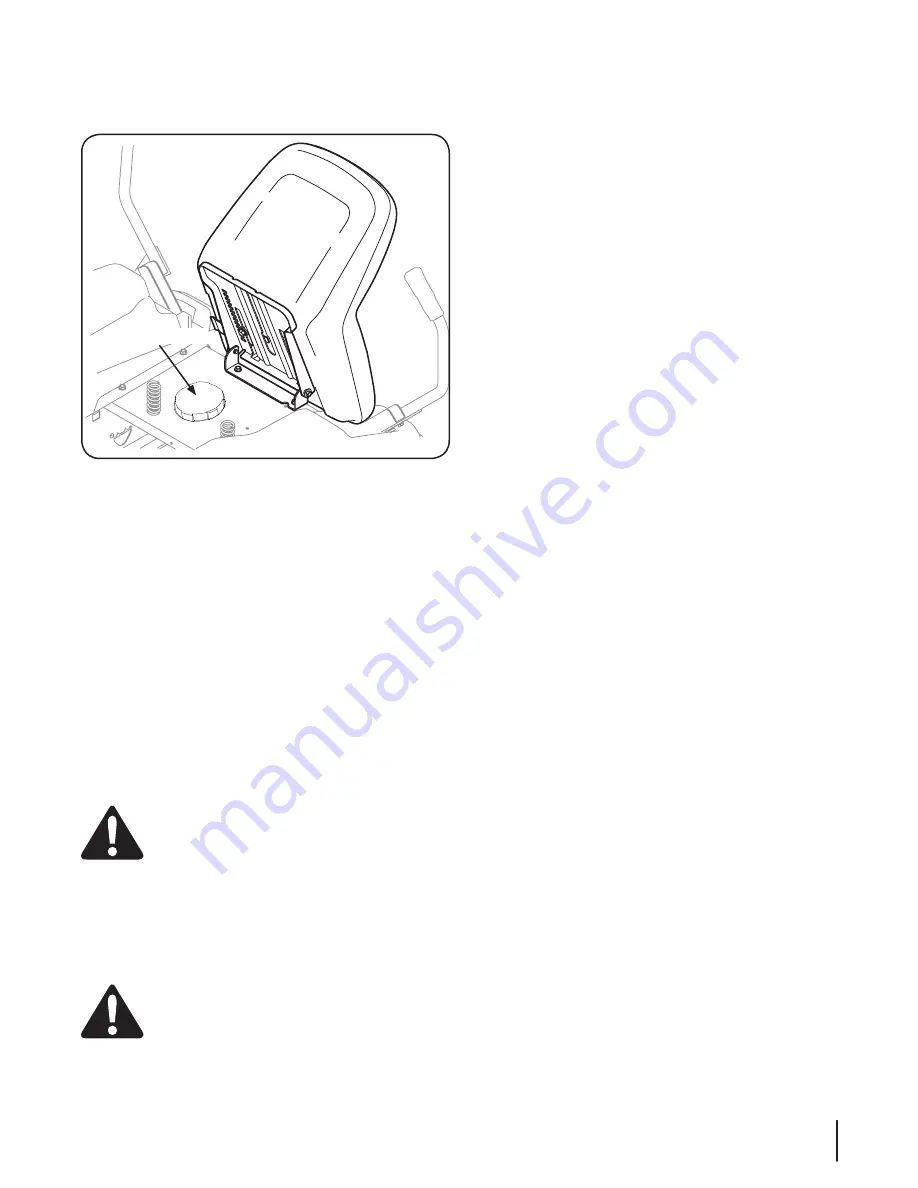
S
ection
6 — M
aintenance
& a
djuStMentS
23
1.
Pivot the operator’s seat forward and clean the reservoir
cap and the area around the cap to prevent debris from
contaminating the transmission oil. See Fig. 6-3.
2.
Turn the reservoir cap counterclockwise to re-move, then
check the oil level in the reservoir. Oil should be visible at
the bottom of the cup, but the oil level must NOT be above
1⁄4
” from the bottom of the cup. DO NOT FILL THE RESERVOIR.
3.
If necessary to add oil because of some type of leakage, use
a quality 20W50 motor oil and add only enough oil to bring
the level within 1⁄4
” of the bottom of the reservoir. Reinstall
the cap and fully tighten.
Tractor Storage
If your tractor is not going to be operated for an extended period
of time (thirty days to approximately six months), the tractor should
be prepared for storage. Store the tractor in a dry and protected
location. If stored outside, cover the tractor (including the tires) to
protect it from the elements. The procedures outlined below should
be performed whenever the tractor is placed in storage.
1.
Change the engine oil and filter following the instructions
provided in the engine manual packed with this manual.
WARNING!
Never store the tractor with fuel in the
tank indoors or in poorly ventilated enclosures, where
fuel fumes may reach an open flame, spark or pilot
light as on a furnace, water heater, clothes dryer, etc.
2.
If storing the tractor for 30 days or more:
a. To prevent gum deposits from forming inside
the engine’s carburetor and causing possible
malfunction of the engine, the fuel system must be
either completely emptied, or the gasoline must be
treated with a stabilizer to prevent deterioration.
WARNING!
Fuel left in the fuel tank deteriorates
and will cause serious starting problems.
b. Using a fuel stabilizer:
•
Read the product manufacturer’s instructions
and recommendations.
•
Add to clean, fresh gasoline the correct
amount of stabilizer for the capacity
(approximately 3 gallons) of the fuel system.
•
Fill the fuel tank with treated fuel and run the
engine for 2-3 minutes to get stabilized fuel
into the carburetor.
c. Emptying the fuel system:
•
Prior to putting the tractor in storage, monitor
fuel consumption with the goal of running
the fuel tank empty.
•
Run the engine until it begins to stall. Use the
choke to keep the engine running until all fuel
in the carburetor has been exhausted.
•
Referring to the engine manual, drain the fuel
from the carburetor bowl.
3.
Clean the engine and the entire tractor thoroughly.
4.
Fully charge the battery, then disconnect the negative
cable at the battery to prevent possible discharge.
Recharge the battery periodically when in storage.
NOTE:
Remove the battery if exposed to prolonged periods
of sub-freezing temperatures. Store in a cool, dry location
where temperatures are above freezing.
5.
Lubricate all lubrication points.
NOTE:
Using a pressure washer or garden hose is not
recommended for cleaning your tractor. It may cause
damage to electrical components, spindles, pulleys,
bearings or the engine. The use of water will result in
shortened life and reduce serviceability.
Removing The Tractor From Storage
1.
Check the engine oil.
2.
Fully charge the battery and inflate the tires to the
recommended pressure.
3.
Fill the fuel tank with clean, fresh gasoline.
4.
Add clean, fresh fuel.
5.
Start the engine and allow to idle for a few minutes to
ensure engine is operating properly.
6.
Drive the tractor without a load to make certain all the
tractor systems are functioning properly.
Reservoir Cap
Figure 6-3
















































